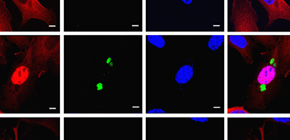
Clarification of how Toxoplasma gondii manipulates host immune response to increase parasite virulence
People can be infected in many ways
A group of researchers led by YAMAMOTO Masahiro (Professor, Research Institute for Microbial Diseases, Osaka University) found that one of the reasons for aggravation of toxoplasmosis was that toxoplasma's pathogenicity factor, dense granule antigen (GRA6), forcibly made use of host innate immune cells by co-opting activation of the host transcription factor nuclear factor of activated T cells 4 (NFAT4), host immunological control molecules.
Toxoplasma gondii is a common parasite and causes the development of fatal encephalosis or myocarditis in immunodeficient patients under treatment of AIDS or cancer. It is also known that people can be infected through, among other ways, consuming undercooked meat or exposure to cat feces. Pregnant women who are infected may suffer a miscarriage or the newborn child may suffer from a congenital disease such as hydrencephalus. Recently the number of such cases in Japan has increased. However, which pathogenicity factor in toxoplasma gondii is involved in the spread from local infection to general infection has been unknown.
This group found:
1. GRA6 secreted by toxoplasma gondii in host cells activates an important host transcription factor NFAT4.
2. NFAT4 activated by GRA6 induces chemokines possessing strong migration ability at the site of the infection and recruits neutrophils, immune cells, to the site of infection, thereby, infecting neutrophils with toxoplasma gondii.
3. By making use of neutrophils as a kind of Trojan horse, toxoplasma gondii spread from the site of infection gradually through the whole body.
Recently the number of toxoplasmosis cases has increased in Japan. The use of drugs to inhibit co-option of the pathway for NFAT4, especially in the early phase of infection, holds promise of preventing the spread and increase of such infections. It is widely expected that this group's results will offer new target for molecular therapy in order to prevent the onset of toxoplasmosis.
Abstract
Toxoplasma gondii infection results in co-option and subversion of host cellular signaling pathways. This process involves discharge of T. gondii effector molecules from parasite secretory organelles such as rhoptries and dense granules. We report that the T. gondii polymorphic dense granule protein GRA6 regulates activation of the host transcription factor nuclear factor of activated T cells 4 (NFAT4). GRA6 overexpression robustly and selectively activated NFAT4 via calcium modulating ligand (CAMLG). Infection with wild-type (WT) but not GRA6-deficient parasites induced NFAT4 activation. Moreover, GRA6-deficient parasites failed to exhibit full virulence in local infection, and the treatment of WT mice with an NFAT inhibitor mitigated virulence of WT parasites. Notably, NFAT4-deficient mice displayed prolonged survival, decreased recruitment of CD11b + Ly6G + cells to the site of infection, and impaired expression of chemokines such as Cxcl2 and Ccl2. In addition, infection with type I parasites culminated in significantly higher NFAT4 activation than type II parasites due to a polymorphism in the C terminus of GRA6. Collectively, our data suggest that GRA6-dependent NFAT4 activation is required for T. gondii manipulation of host immune responses to maximize the parasite virulence in a strain-dependent manner.

Figure 1

Figure 2

Figure 3

Figure 4

Figure 5
To learn more about this research, please view the full research report entitled " Selective and strain-specific NFAT4 activation by the Toxoplasma gondii polymorphic dense granule protein GRA6 " at this page of the Journal of Experimental Medicine website.
Related link :

